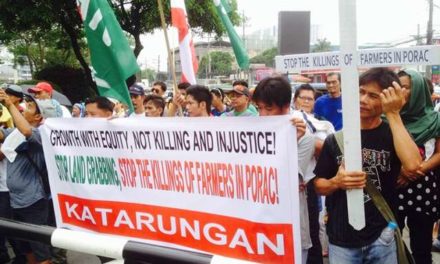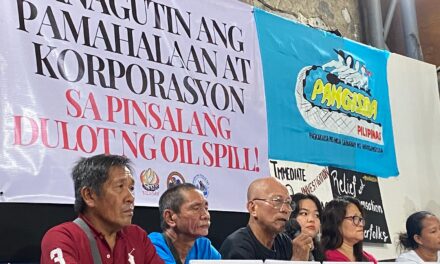by Walden Bello
originally published in the Philippine Daily Inquirer
Honolulu. If he has not left yet, I would advise President Aquino to skip the APEC Summit here in Honolulu. It’s really not worth his time or the country’s money.
I still remember in the early 1990’s, when APEC was one of the key battlegrounds against neoliberalism and free trade. The Uruguay Round of negotiations was stalled, and President Bill Clinton proposed and pushed for the Asia Pacific Free Trade Area as a US-centered trading bloc that would counter the European Union if the Uruguay Round failed. That first effort to create an APEC FTA failed, when the Osaka Summit in 1995 affirmed the position that liberalization would be carried out “voluntarily, flexibly, and in a non-binding fashion,” which had been pushed by key ASEAN countries along with Japan.
How Neoliberalism Ravaged the Asia Pacific
The Asia Pacific free trade area might have failed, but it was but one of the weapons that the neoliberal establishment that was then the dominant school of economic ideology deployed to pry open the Asian economies to free trade and the unrestricted flow of capital.
Working via the International Monetary Fund (IMF), Washington pressured the Asian economies to remove controls on the capital flows to enable New York-based speculators to have a piece of the so-called “Asian Miracle.”
The Southeast Asian economies agreed to the IMF prescription, and $100 billion in speculative capital flowed into East Asia in the period 1994-1997.
This massive infusion of dollars led to overinvestment in real estate and the stock market, and when profits collapsed, the speculators panicked and fled. Some $100 billion left the region in a few weeks in the summer of 1997, bringing down the economies of Thailand, Philippines, Korea, Malaysia, and Indonesia.
Only those countries that did not follow the IMF advice to liberalize their capital accounts, the most notable example of which was China, did not go under.
In the midst of the crisis, the US backed the IMF stabilization plan, which was to provide the Asian governments with billions of dollars to rescue their creditors in return for their agreement to follow austerity programs that made the situation worse and plunged many economies into recession.
At their deepest moment of crisis, Washington took advantage of the situation to force Thailand, Indonesia, and Korea to liberalize many of their laws on trade, capital movement, and investment.
These opportunistic moves left such a bad taste among citizens and governments in the region that countries built up multibillion dollar reserves to thwart future efforts by speculators to target their currencies rather than go for help to Washington and the IMF. And for all intents, it froze any further initiatives at trade liberalization as well as economic cooperation within APEC.
Both Asian governments and their citizens remarked bitterly that the last thing they got from the Asia Pacific Economic Cooperation was cooperation from the US.
APEC and the US “War on Terror”
But in the next few years, the US demanded cooperation from the Asian countries, but this time, it stressed political and military cooperation in the US’s so-called “War on Terror.” The APEC Summit in Shanghai in November 2001 emphasized political instead of economic objectives, with APEC governments endorsing a US-crafted communiqué condemning the September 11 terrorist attacks on the US and pledging “to strengthen international cooperation at all levels in combating terrorism in a comprehensive manner.”
Most of the APEC countries, however, confined their support mainly to rhetorical denunciations of terrorism, except for one government, the Philippines. The administration of Gloria Macapagal-Arroyo welcomed US Special Forces’ participation in military actions against Islamic fundamentalists in the Southern Philippines, for which the country’s status was upgraded – some would say downgraded – into a “major non-NATO ally.” The US role, according to many analysts, has worsened rather than improved the situation in the South.
Today’s Geoeconomic Rivalry
In recent years, Washington has renewed its drive to create a pan-Pacific tree trade area under its leadership.
This time, the project is called the Trans-Pacific Partnership (TPP), and aside from the US, participants in the negotiations include Brunei, Chile, New Zealand, Singapore, Peru, Australia, Vietnam, and Malaysia.
The objective of the original agreement was to reduce all trade tariffs to zero by the year 2015. It aims to be a comprehensive agreement covering all the main pillars of a free trade agreement, including trade in goods, rules of origin, trade remedies, sanitary and phytosanitary standards , technical barriers to trade, trade in services, intellectual property, government procurement and competition policy. It is what analysts describe as “WTO-plus,” meaning it is more stringent in its hewing to free trade and intellectual property rules than the WTO.
The intent of the US is the same as in the 1990’s, but its free trade push is being pursued in a new context. First of all, like the conclusion of the Doha Round of the WTO, the TPP is seen by Washington as one method by which it can revive its economy from the state of stagnation to which it has been brought by the financial crisis. Second, its TPP push is a defensive reaction to China’s major successes in its economic diplomacy in the region, particularly the forging of the China-ASEAN Agreement of 2002 (CAFTA), which took effect at the beginning of last year.
Touted as the world’s biggest Free Trade Area, CAFTA is billed as having 1.7 million consumers, with a combined gross domestic product of $ 2 trillion and total trade of $ 1.3 trillion. Under the agreement, trade between China and six Asean countries including Brunei, Indonesia, Malaysia, the Philippines, Thailand and Singapore has become duty-free for more than 7,000 products. By 2015, the newer Asean countries, Vietnam, Laos, Cambodia and Myanmar, will join the zero-tariff arrangement.
Like the case of the United States in the case of the TPP, CAFTA is likely to favor the hegemonic power and its economic elite. Thus, beneath the surface good will of the APEC summits, we see the world’s largest economy and its second largest maneuvering for position to achieve economic hegemony in the world’s most dynamic region. China is ahead, not simply because it was able to forge a wide-reaching trade agreement but also because over the last 20 years, it has been able to integrate the rest of East Asia into its economy. Other East Asian countries supply the raw materials and components that foreign and Chinese manufacturers in China put together into finished products exported to the US and Europe.
Of course, at present the dynamics of competition are moderated by the so-called complementary relationship between the world’s largest economies, with China’s export-oriented manufacturing base continuing to depend on the US market and the US continuing to depend on credit from China. But with China realizing it must cultivate other markets and the US trying to achieve predominance in Asia-Pacific markets in order to rebuild its eroded export capacity, competition will increasingly dominate in the relationship.
Geopolitical Jockeying
Even as their geoeconomic rivalry worsens, the geopolitical jockeying between the two powers has intensified. Ever since its offensive across the Pacific in the Second World War, the US has never demobilized its forces in the Western Pacific, and over time, strategically, Washington has considered the ocean an American lake policed by the US Pacific Command based in Honolulu.
Unlike in Europe, Washington has preferred to deal with crises in the region not through multilateral mechanisms like the North Atlantic Treaty Organization but unilaterally, by deploying the Navy and sending in the marines. The reason that the Southeast Asian countries’ effort to make the ASEAN Regional Forum (ARF) a multilateral mechanism for settling regional disputes failed is because the US was so busy undermining it.
Today, in Southeast Asia, the big question people are asking is, has China shed the low-profile military posture that Deng Hsiao Ping advocated so that the country could focus on economic development? There are disturbing indications that it has and that it is following the unilateralist course trodden by the United States. This is most evident in the dispute over the Spratly Islands in the West Philippine Sea (formerly the South China Sea).
China has not only rejected a multilateral settlement of conflicting territorial claims, which is the only viable way of addressing the issue when there are six different claimants. To widespread consternation and anger, it has claimed the whole West Philippine Sea – formerly the South China Sea – as its own, right up to the 12-mile territorial limit of countries like Vietnam and the Philippines.
And in case there was any doubt about Beijing’s unilateral mood in setting the issue, the Global Times, an influential Communist Party mouthpiece, recently warned Vietnam and the Philippines thus: “If these countries don’t want to change their ways with China, they will need to mentally prepare for the sounds of cannons. We need to be ready for that, as it may be the only way for the disputes in the sea to be resolved.”
The question people in the region are now asking themselves is: does this statement reflect official thinking or is it saber rattling to support a diplomatic stance. Either way, it reflects a view that is hostile to multilateralism.
Of course, one must not make the mistake of thinking that China’s military power is in any way at par regionally with that of the US in conventional terms. China is probably decades away from coming close to regional parity.
Its recent launching of an aircraft carrier that was bought from Ukraine to be originally used as a casino is hardly, as the Economist put it, a symbol of Chinese “prowess.” The creation of a carrier battle-group and mastery of its combat tactics are years away, and the Chinese know it. But what is important here is the symbolism. With its launch of a carrier, China has signaled its neighbors and the world of its intention to become a naval power, even if that status will take a few decades to attain.
Towards a Truly Relevant Multilateral Association
Ever since the APEC Trans-Pacific Free Trade Area initiative failed in the mid-1990’s, APEC has served mainly as a bully pulpit for the US to promote its economic and political objectives, while other members have professed to see it as a useful forum for dialogue. What is clear to many analysts is that it has ended up as a club with no clear direction or function. To address the many critical problems that the Asia Pacific region faces today, APEC is next to useless. At no other time has the region been in need of an effective non-partisan multilateral association.
What are the key issues that must be addressed today by such a body?
Well, as evident from our discussion above, there is the threat of the smaller economies being caught in the middle of the geoeconomic rivalry between the US and China. We need a multilateral body that would assure the smaller countries and less developed economies of the region, including the Pacific Island economies, the space in which they can develop their strategies of sustainable development, free from the deadly dynamics of free trade and finance capital.
Also evident from our discussion above, geopolitical rivalry between the US and China appears to be the trend. A truly non-partisan multilateral body would act to contain this threat in cooperation with the United Nations instead of serving as a forum for saber-rattling and browbeating governments, as APEC did for the United States.
At the same time, it could serve as a mechanism for the peaceful resolution of disputes, of which there are a number in the region, some of which have erupted into hostilities, like the Preah Vihear Temple conflict between Thailand and Cambodia. APEC has been too US-oriented, and the ASEAN Regional Forum has lacked broad-based legitimacy, to serve this purpose. The most critical conflicts that such a pea ce-building body should address are the continuously volatile situation in the Korean peninsula and the territorial disputes in the West Philippine Sea, formerly known as the South China Sea.
A third area that cries out to be addressed by a non-partisan pan-Pacific body is the very advanced environmental crisis in the APEC area. Despite its oft-stated commitment to deal with climate change, APEC has not dared to nudge the US and China, the world’s two biggest greenhouse gas emitters, towards a mandatory agreement to reduce their emissions.
Yet climate change has become very pronounced in the APEC region. In the last year alone, in the APEC region, extreme weather events have ravaged Russia, China, Australia, Laos, Cambodia, Vietnam, the Philippines, and Thailand. As everyone watching television knows, the great city of Bangkok is being besieged by floodwaters from the wettest monsoon ever.
Let us face it. When it comes to climate change and other environmental crises sweeping the region, such as deforestation, overfishing, and the alarming loss of biodiversity, APEC has been next to useless.
A fourth problem that a non-partisan multilateral body must address is the condition of migrant workers. Waves of migrant workers now regularly cross borders in the APEC region, from Indonesia to Malaysia, from the Philippines to Singapore and Hong Kong, from China to Japan and the United States. A great many of these labor migrants are not documented, thus subjecting them to abuse by labor traffickers and severe exploitation in their host economies.
Even when they have papers, migrant workers often do not enjoy many of the rights other workers are entitled to. And most face the fundamental inequity of contributing one’s labor to the host economy year in and year out and not being able to settle there.
A fifth problem throughout the APEC region is the dismal condition of indigenous peoples. From the Maori of Aotearoa to the people of West Papua who are struggling for independence to the Hawaiʻi maoli, indigenous, aboriginal peoples are treated as second class citizens. APEC has been totally irrelevant to the needs and demands of these people.
In sum, there are great problems in the region that cry out for solutions from a truly partisan multilateral association of states, one that is not under the thumb of hegemonic powers, that serves as a constructive forum for member states at par with one another and where civil society is also given representation.
The work of establishing such a body will most likely fall on the smaller states, working with a vibrant civil society that now cooperates across borders. This forum here today is an example of the voice civil society networks throughout the region can achieve if we choose to unite our efforts. More than ever, as governments falter or turn inwards or scale down their ambitions, the voice of civil society is needed, the vision of civil society is needed, the intervention of civil society is needed to create a regional association that really serves the interest of the pan-Pacific community.
*Walden Bello is representative of Akbayan (Citizens’ Action Party) in the House of Representative of the Republic of the Philippines and senior analyst at the Bangkok-based institute Focus on the Global South. A retired professor from the University of the Philippines, he has authored or co-authored 15 books, includingDilemmas of Domination: the Unmaking of the American Empire, APEC: Four Adjectives in Search of a Noun, American Lake: the Nuclear Peril in the Pacific, and, most recently, Food Wars.









